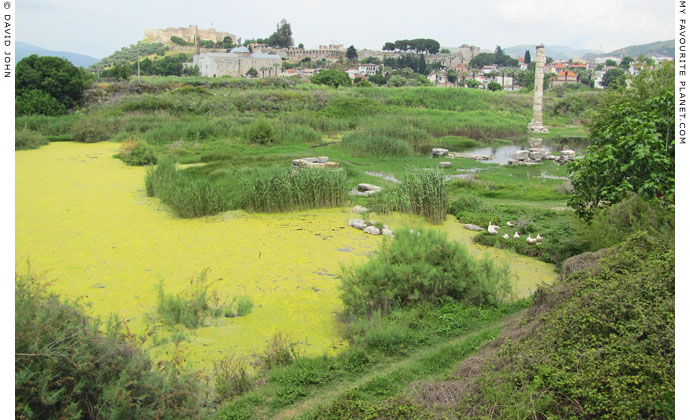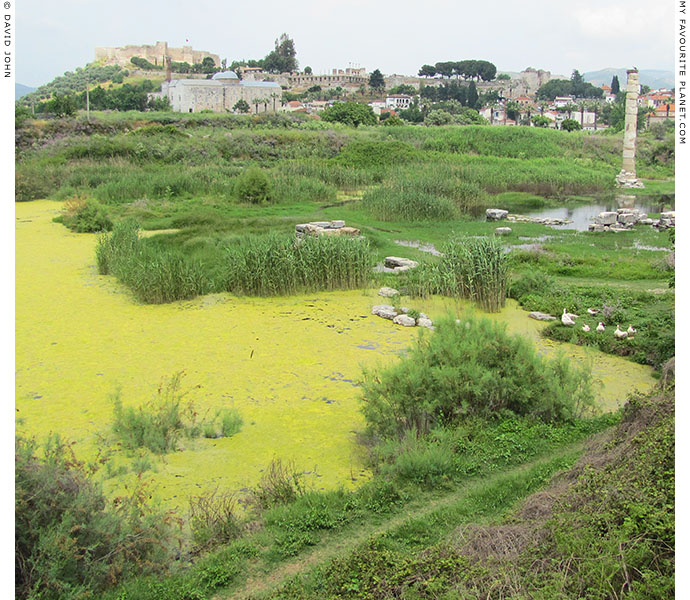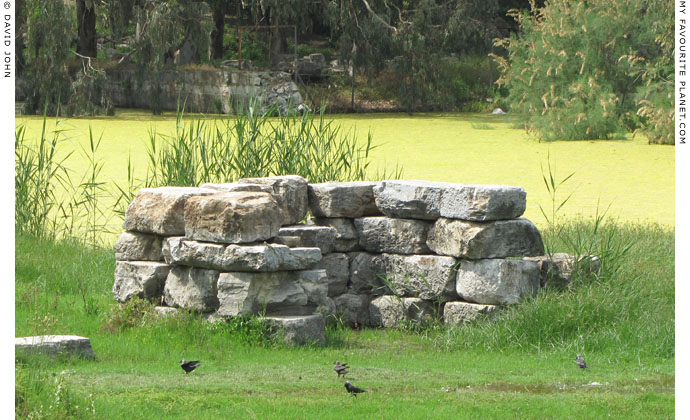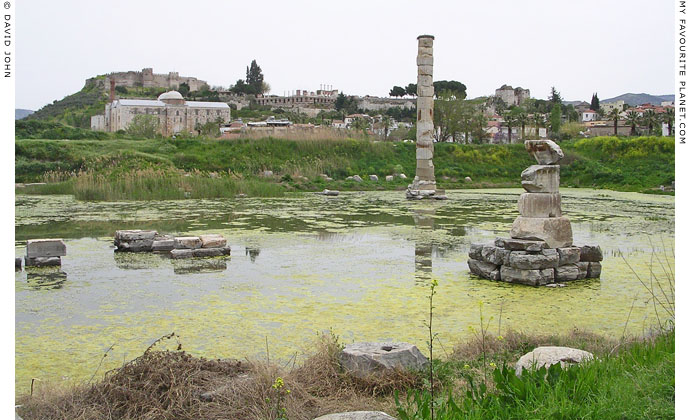|
|
|
| My Favourite Planet > English > Middle East > Turkey > Selçuk > photo gallery 1 |
| Selçuk gallery 1 |
Selçuk town |
 |
 |
3 of 30 |
 |
 |
|
| |

The ruins of the Temple of Artemis (3rd century BC) and its submerged sanctuary. |
| |
Temple of Artemis
Part 1
The Artemision; Turkish, Artemis Tapinaği
Just outside Selçuk, along the road to Ephesus Archaeological Site, 100 metres from Selçuk bus station (otogar) and Ephesus Archaeological Museum.
Open every day
Summer (April-October): 08:00 - 19:00
Winter (November-March) 08:30 - 18:00
Admission FREE
It may be difficult to believe from its sorry state, but the Temple of Artemis (Greek, Ἀρτεμίσιον Ἐφέσιον, Artemision Ephision) was once one of Philo of Byzantium's Seven Wonders of the World. The first known mention of this list of sights was by the Greek epigrammatist Antipater of Sidon (2nd century AD) who wrote:
"I have set eyes on the wall of lofty Babylon, on which there is a road for chariots, and the statue of Zeus by the Alpheus, and the hanging gardens, and the Colossos of the Sun, and the huge labour of the high pyramids, and the vast tomb of Mausolus. But when I saw the house of Artemis that mounted to the clouds, those other marvels lost their brilliance, and I said. "Lo, apart from Olympus, the sun never looked on anything so grand."
Antipater of Sidon (Greek Anthology, 9.58)
The cult of the fertility and earth-mother goddess Artemis Ephesia (see photos of statues of Artemis Ephesia in Ephesus Museum, Selcuk) in Anatolia and Greece goes back into prehistory. In Ionia she is often referred to as Cybele-Artemis, since following the arrival of the Ionian Greeks here around 1000 BC, she supplanted or assimilated the ancient Anatolian mother goddess Kybele (Κυβέλη).
According to local mythology, the goddesss Leto (Greek, Λητώ; Latin, Latona) gave birth to the twins Artemis and Apollo in or near Ephesus, at a place known as Ortygia (Ὀρτυγία) on Mount Koressos. [1]
The annual festival in honour of Artemis, known as Artemisia or Ephesia, lasted several days. It included sporting and musical competitions and a procession, during which a festively decorated cult statue of Artemis was carried through the city of Ephesus. This was also seen as the visit by the goddess to the city. Starting from the temple, the procession took the part of the Sacred Way (see Ephesus gallery page 12) known as the Kathodos (literally, the way down) to the Magnesian Gate, at the east of the city, through the Upper Agora, down the Kuretes Street, to the Great Theatre. From there it returned to the temple along the Anados (the way up), via the Theatre Street, leaving the city via the colonnaded street between the Stadium and the Vedius Gymnasium and through the Koressos Gate.
Archaeologists have dated the oldest known Artemis sanctuary (Greek, Ἀρτεμίσιον, Artemision) on this site to the 8th century BC. This seems to have been destroyed during Cimmerian invasions in the 7th century BC.
Its replacement, designed by the Cretan architect Cherisphron in the form of an Ionic octastyle (eight columns at the front and rear) dipteros (completely surrounded by double rows of columns) [2], was completed in 550 BC, took 120 years to build, was the first monumental building made entirely of marble, and at that time the largest in structure the Greek world. Many of its columns, decorated with reliefs, were paid for by the fabulously rich King Croesus of Lydia, who was half Greek and ruled parts of Anatolia 560 - 546 BC.
This "old" or "archaic" temple was destroyed by a fire in 356 BC, said to have been on the same night as Alexander the Great's birth [3]. The fire was allegedly started by Herostratus (Ἡρόστρατός) in order to achieve eternal fame. He seems to have been successful so far.
Continued on the next page > |
|

The lone reconstructed column
of the Artemis Temple serves
as a base for a stork's nest.
See more photos of storks
in Selçuk and Ephesus
in Ionian Spring part 3,
at The Cheshire Cat Blog. |
|
| |

The submerged ruins of the Temple of Artemis.
|
In the centre of the photo are the remains of the altar (see photo below), and below is the narrow footpath which leads around the south side of the temple. In the background, left, are the Isa Bey Mosque (Isa Bey Camii, built 1375, see gallery page 15). Behind it stands the Byzantine citadel (acropolis) of Ayasuluk (gallery page 2), which at present is closed to the public. Along the hill to the right of the citadel are the ruins of the Basilica of Saint John (gallery pages 5-13).
It is difficult to imagine the enormous Temple of Artemis standing here in its glory days from a few submerged stones and a wobbly-looking reconstruction of a column. However, the area of the sacred precinct is huge, and the column is nevertheless impressively gigantic. Remains of other buildings within the sanctuary can also be glimpsed between the wild vegetation. The deep hollow left by John Turtle Wood excavations in 1869 now forms an artificial pond, here covered by algae, which provides a home for geese and other birds. |
|
|
| |

The reconstructed remains of the altar of the Temple of Artemis (3rd century BC). |
| |

The foundations of the Temple of Artemis lie beneath the current water table and are often
submerged in water, as in this photo, taken after heavy spring heavy rain in April 2004. |
| |
Artemis
Temple
Ephesus
Selçuk |
Notes, references and links |
 |
|
1. The birthplace of Artemis and Apollo at Ephesus
There were two mountains in the area named Koressos, but some scholars have believed that the Mount Koressos (Greek, όρος Κορησσός; Turkish, Bülbül Daği, Nightingale Mountain) immediately south of the Hellenistic city of Ephesus (the archaeological site of Ephesus) was the location of the myth. Koressos was also the name of the Hellenistic city's harbour district, and some also believe that it was the original location of Ephesus before it was abandoned in the mid 6th century BC and moved further inland.
The Greek geographer Strabo described the coast around Ephesus and the nearby wooded area named after Ortygia (Ὀρτυγία, from ὄρτυξ, ortyx, quail), who assisted Leto when she gave birth to Artemis and Apollo there.
"Then comes the harbour called Panormus, with a temple of the Ephesian Artemis; and then the city Ephesus.
On the same coast, slightly above the sea, is also Ortygia, which is a magnificent grove of all kinds of trees, of the cypress most of all. It is traversed by the Cenchrius River, where Leto is said to have bathed herself after her travail. For here is the mythical scene of the birth, and of the nurse Ortygia, and of the holy place where the birth took place, and of the olive tree near by, where the goddess is said first to have taken a rest after she was relieved from her travail.
Above the grove lies Mount Solmissus, where, it is said, the Curetes stationed themselves, and with the din of their arms frightened Hera out of her wits when she was jealously spying on Leto, and when they helped Leto to conceal from Hera the birth of her children.
There are several temples in the place, some ancient and others built in later times; and in the ancient temples are many ancient wooden images, but in those of later times there are works of Scopas; for example, Leto holding a sceptre and Ortygia standing beside her with a child in each arm.
A general festival is held there annually; and by a certain custom the youths vie for honor, particularly in the splendor of their banquets there. At that time, also, a special college of the Curetes holds symposiums and performs certain mystic sacrifices."
Strabo, Geography, Book 14, chapter 1, section 20. At Perseus Digital Library.
The Byzantine scholar Stephanus Byzantinus (Constantinople, 6th century AD), working from ancient sources, reported that Leto gave birth here, and wrote that when Artemis later asked, "Whose place is this?", she was told, "Yours" (χόρι σὸς, chori sos), thus giving the mountain its name.
Stephanus Byzantinus, Περὶ πόλεων (Peri poleon; Latin, De Urbibus).
Thomas de Pinedo, Stephanos Peri poleon = Stephanus De urbibus. "Κορησσός (Corissos)", page 375. Greek and Latin in parallel columns. Jacobi de Jonge, Amsterdam, 1678. At the Internet Archive.
Ortygia (Ορτυγία), also named by ancient authors as the place where Leto gave birth, is associated by some with Ephesus, but several other places share this name, including the island of Syracuse, Sicily.
The Cycladic island Delos, the Cretan islands of Paximadia (Παξιμάδια, ancient Letoai) and Letoon (Λητῶον), between Xanthos and Patara in Lycia (near Kumluova, southwestern Turkey) also claimed to be the birthplace of Artemis and Apollo.
The Roman senator and historian Tacitus (circa 56-120 AD), who was at Ephesus as proconsul of Asia 112-113 AD, recorded the Ephesians' claim that Artemis and Apollo were born on their territory, when they were defending their ancient right of asylum for the sanctuary of Artemis before the Roman Senate during the reign of Emperor Tiberius (14-37 AD):
"First of all came the people of Ephesus. They declared that Diana and Apollo were not born at Delos, as was the vulgar belief. They had in their own country a river Cenchrius, a grove Ortygia, where Latona, as she leaned in the pangs of labour on an olive still standing, gave birth to those two deities, whereupon the grove at the divine intimation was consecrated.
There Apollo himself, after the slaughter of the Cyclops, shunned the wrath of Jupiter [Zeus]; there too father Bacchus [Dionysus], when victorious in war, pardoned the suppliant Amazons who had gathered round the shrine. Subsequently by the permission of Hercules [Herakles], when he was subduing Lydia, the grandeur of the temple's ceremonial was augmented, and during the Persian rule its privileges were not curtailed. They had afterwards been maintained by the Macedonians, then by ourselves."
Publius (or Gaius) Cornelius Tacitus (circa 56 - after 117 AD), The Annals, Book III, chapter 61. At Perseus Digital Library.
Alfred John Church, William Jackson Brodribb, Sara Bryant, Complete Works of Tacitus. Random House, New York. Reprinted 1942.
See also Strabo's comments on the temple's tradition of asylum ("refuge") on the next page. |
|
|
2. Vitruvius on the Temple of Diana (Artemis) at Ephesus
As a Roman, Vitruvius (circa 80-15 BC) refers to Artemis as Diana. He also mentions that the coffered ceilings of the temple were made of cedar wood (Book II, chapter 9, Timber, section 13).
"The dipteral also is octastyle in both front and rear porticoes, but it has two rows of columns all round the temple, like the temple of Quirinus, which is Doric, and the temple of Diana at Ephesus, planned by Chersiphron, which is Ionic."
Vitruvius, On Architecture, Book III, chapter 2, Classification of temples, section 7.
Although Virtuvius wrote "The dipteral also is octastyle" (octastyle = eight columns at the front and rear), as early as the mid 19th century the British architect Edward Falkener, who visited Ephesus in 1845 (see A brief history of Ephesus), reasoned that the temple was not octastyle but decastyle, and interpreted Virtuvius' statement to mean that dipteral is "not less than octastyle: 'Dipteral temples are octastyle (at least)...'"
Edward Falkener (1814-1896), Ephesus and the Temple of Diana, page 246. Day & Son, London, 1862.
"For in four places only are the temples embellished with work in marble, and from that circumstance the places are very celebrated, and their excellence and admirable contrivance is pleasing to the gods themselves. The first is the temple of Diana [Artemis] at Ephesus, of the Ionic order, built by Chersiphron of Gnosus, and his son Metagenes, afterwards completed by Demetrius, a priest of Diana, and Paeonius the Ephesian.
The second is the temple of Apollo at Miletus, also of the Ionic order, built by the above-named Paeonius, and Daphnis, the Milesian."
Vitruvius, The ten books on architecture, Book 7, Introduction, section 16. At Bill Thayer's LacusCurtius website, University of Chicago.
Vitruvius tells us how the marble column shafts for the temple was transported from the quarry to the site, as well as the story (legend?) of how the local source of marble, "where it can be dug out all ready to use" (Book VII, chapter VI), was discovered at Ephesus:
"I will digress a bit and explain how these stone-quarries were discovered. Pixodorus was a shepherd who lived in that vicinity. When the people of Ephesus were planning to build the temple of Diana in marble, and debating whether to get the marble from Paros, Proconnesus, Heraclea, or Thasos, Pixodorus drove out his sheep and was feeding his flock in that very spot. Then two rams ran at each other, and, each passing the other, one of them, after his charge, struck his horns against a rock, from which a fragment of extremely white colour was dislodged.
So it is said that Pixodorus left his sheep in the mountains and ran down to Ephesus carrying the fragment, since that very thing was the question of the moment. Therefore they immediately decreed honours to him and changed his name, so that instead of Pixodorus he should be called Evangelus. And to this day the chief magistrate goes out to that very spot every month and offers sacrifice to him, and if he does not, he is punished."
Book X, chapter 2, Hoisting machines, section 15.
He also had this to say about architects' estimates at Ephesus:
"In the famous and important Greek city of Ephesus there is said to be an ancient ancestral law, the terms of which are severe, but its justice is not inequitable. When an architect accepts the charge of a public work, he has to promise what the cost of it will be. His estimate is handed to the magistrate, and his property is pledged as security until the work is done.
When it is finished, if the outlay agrees with his statement, he is complimented by decrees and marks of honour. If no more than a fourth has to be added to his estimate, it is furnished by the treasury and no penalty is inflicted. But when more than one fourth has to be spent in addition on the work, the money required to finish it is taken from his property.
Would to God that this were also a law of the Roman people, not merely for public, but also for private buildings. For the ignorant would no longer run riot with impunity, but men who are well qualified by an exact scientific training would unquestionably adopt the profession of architecture. Gentlemen would not be misled into limitless and prodigal expenditure, even to ejectments from their estates, and the architects themselves could be forced, by fear of the penalty, to be more careful in calculating and stating the limit of expense, so that gentlemen would procure their buildings for that which they had expected, or by adding only a little more.
It is true that men who can afford to devote four hundred thousand to a work may hold on, if they have to add another hundred thousand, from the pleasure which the hope of finishing it gives them; but if they are loaded with a fifty per cent increase, or with an even greater expense, they lose hope, sacrifice what they have already spent, and are compelled to leave off, broken in fortune and in spirit."
Book X, Introduction, sections 1 and 2.
Vitruvius, The ten books on architecture, translated by Morris Hicky Morgan and Albert A. Howard. Harvard University Press and Oxford University Press, 1914. At Project Gutenberg.
See also Bill Thayer's English version, Vitruvius: On Architecture, at his LacusCurtius website, University of Chicago.
3. The fire at the Temple and the birth of Alexander
The Roman statesman, rhetorician and philosopher Cicero (106-43 BC), citing the historian Timaeus, was among those who related the story that Diana (Artemis) was too busy assisting in Alexander's birth in Macedonia to prevent her temple in Ephesus being destroyed by fire.
"This occasioned a pleasant observation of Timaeus (as he has many). Having said in his history that 'the same night in which Alexander was born, the temple of Diana at Ephesus was burned down,' he adds, 'It is not in the least to be wondered at, because Diana, being willing to assist at the labor of Olympias [Alexander's mother], was absent from home.'"
Cicero, De Natura Deorum (On the Nature of the Gods), Book 2, chapter 27. In: Cicero's Tusculan disputations; also Treatises on the nature of the gods, and On the commonwealth. Translated by Charles Duke Yonge. Harper & Brothers, New York, 1877. At Project Gutenberg. |
|
|
Map, photos and articles: © David John,
except where otherwise specified.
Additional photos: © Konstanze Gundudis
All photos and articles are copyright protected.
Images and materials by other authors
have been attributed where applicable.
Please do not use these photos or articles without permission.
If you are interested in using any of the photos for your
website, project or publication, please get in contact.
Higher resolution versions are available on request. |
|
| |
 |
Visit the My Favourite Planet Group on Facebook.
Join the group, write a message or comment,
post photos and videos, start a discussion... |
|
|
| |
|
|
|